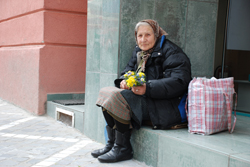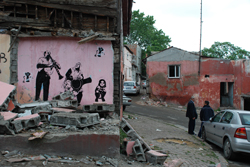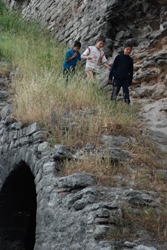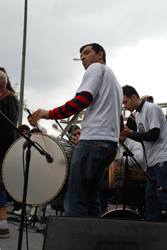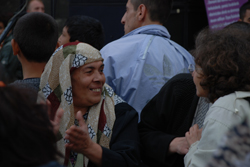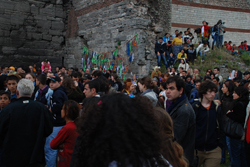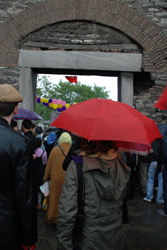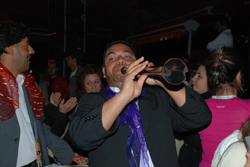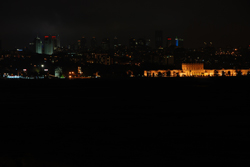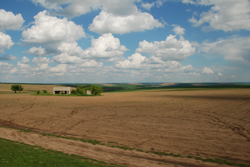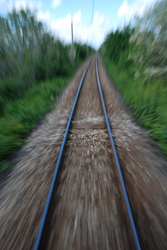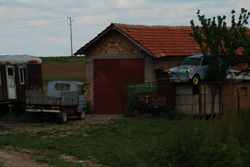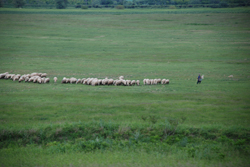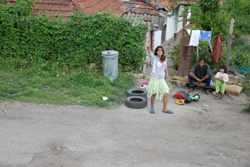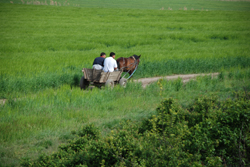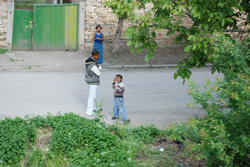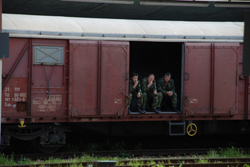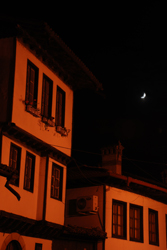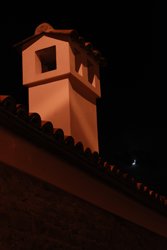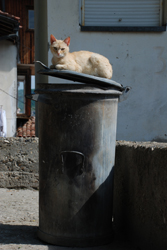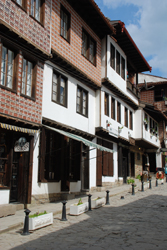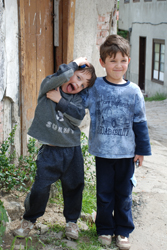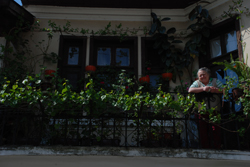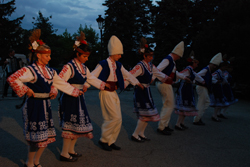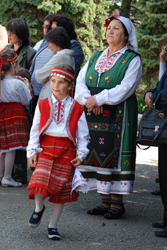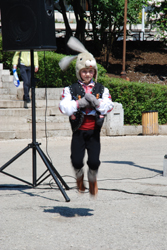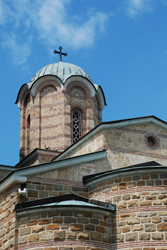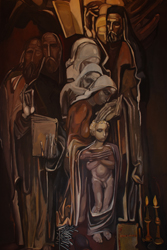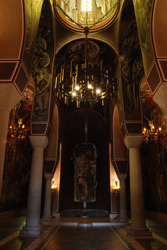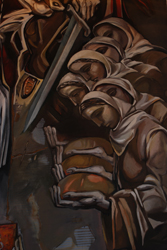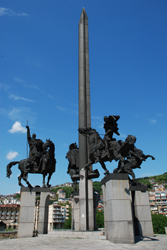Hidrellez: Spring Festivals in Istanbul
13 May, 2008, 05:04 am in "Turkey"
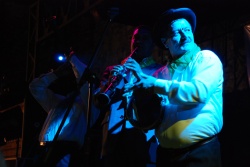 Sunday (May 7 2008) was the Sulukule Hidrellez festival. David, an expat musician we had met at the Middle Eastern Music and Dance camp, had e-mailed me about it. We met up with Dianne and some of her friends and bussed to Edirnekapi. Sulukule has been known for being a gypsy neighborhood where there used to be small clubs with music and dance. Now, however, the city is "cleaning" the area which involves condemning lots of houses. Many lots were already filled with rubble from the bulldozed houses. This Hidrellez festival will probably be the last in the neighborhood. Sulukule is just inside the city walls. As we walked toward the area where the festival was, we noticed a painting of musicians on the remains of a wall.
Sunday (May 7 2008) was the Sulukule Hidrellez festival. David, an expat musician we had met at the Middle Eastern Music and Dance camp, had e-mailed me about it. We met up with Dianne and some of her friends and bussed to Edirnekapi. Sulukule has been known for being a gypsy neighborhood where there used to be small clubs with music and dance. Now, however, the city is "cleaning" the area which involves condemning lots of houses. Many lots were already filled with rubble from the bulldozed houses. This Hidrellez festival will probably be the last in the neighborhood. Sulukule is just inside the city walls. As we walked toward the area where the festival was, we noticed a painting of musicians on the remains of a wall.Historical Sulukule
We hurried towards the music which was in a park area just outside the wall, accessed through a gate. Davuls, clarinet, violin and darbukas. People were dancing and clapping. There was a huge number of foreigners.
Unfortunately a down pour started. The stage had no tent so they threw a tarp over the equipment and the musicians rushed their instruments to safety.
Monday evening we went to another Hiderlezi festival. This one was in Ahirkapi near Sultanahmet and sponsored by the city. It was a street festival and was packed. We managed to squeeze into a courtyard and slowly move toward the stage. Halfway there, a brass band decided to stop and play right in front of us which was very convenient because moving toward them from another location would have been difficult. When they finished, we continued toward the stage. Drummers, clarinetists and a zurna player were working their way through the crowd to the stage.
Since Kocani was playing at a different location, we squeezed out the gate and down the street. The crowd was so packed into the street, it was impossible to get into the venue or beyond. We fled to the outside of the wall. I tried to see if there was another way in and found a smaller gate a little further down. For about 10 feet I was able to walk normally but soon I was once again in one of those crowds where you give up movement of your own free will and just let yourself be pushed in some direction. Even this movement stopped as the street jammed up in front of a stage. I gave up and forced my way back out. At one point I saw a group of musicians trying to fight their way through the crowd. The zurna player made an ambulance siren sound with his zurna.
Rowshan and I sat by the Marmara Sea, glad to be out of the crush. It was there we noticed that Istanbul had developed a modern city skyline in Levent. Where before there had just been a couple tall buildings, now there were a cluster of rectangular towers with a smattering of lights shining from their windows.
Veliko Tarnovo: A Bulgarian Hill Town
12 May, 2008, 12:46 am in "Bulgaria"
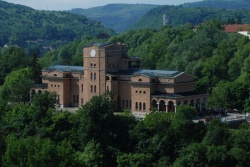 The region around Veliko Tarnovo seems to be where the flatlands end and the foothills begin.
The region around Veliko Tarnovo seems to be where the flatlands end and the foothills begin.The hills are thickly covered with trees. Light gray cliffs form Cheshire cat grins at the tops of the hills. Here and there rivers loop beneath the tracks and alongside the railroad. People, farmlands, and other railroad scenes flow by.
The train stations and buildings alongside the track are mostly of the sad boxy concrete variety. Veliko Tarnovo, besides being located in the hills, stands out due to its height above the tracks. Though its status as a city is visually apparent from the many concrete apartment buildings, the prominent feature is a pretty church floating above the trees, looking down on the river which wraps around the base of the hills.
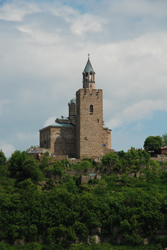
Though it has its share of modern boutiques, bars, restaurants, and an overabundance of real estate agencies with ads in English, farther up the hill, these all seem to fade away to reveal an extremely cute old town with stone arches, white washed walls, art galleries and souvenir shops. The streets become narrower and the pavement is replaced with flagstones.
The hostel we stayed in was even farther up the hill. Below it was the river chasm and rising across the river was the fortress walls and church.
We settled in then went down town where we caught the end of the days performances, part of a 2 week long Balkan folk festival. Older women in traditional costumes sang and danced.
We settled in then went down town where we caught the end of the days performances, part of a 2 week long Balkan folk festival. Older women in traditional costumes sang and danced.
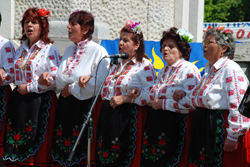
There were accordions, davuls, and kemances. There were also younger participants, kids and teens who danced and sang.
Around 9 we went to a restaurant that was considered one of the best in town. However, after receiving only one of our dishes after an hour and a half. And then waiting another half hour for another until we were eventually informed (after numerous questioning) there had been a mistake and it had never been started, we took our painfully empty stomachs to another restaurant, where I am happy to say we were served in a more timely manner, enabling us to finish dinner before midnight.
Although the train to Istanbul stops in Veliko Tarnova on Sundays, it turns out you cannot buy tickets there since the international ticket seller doesn't work on Sunday. So, Deena and I took a bus to Gorna Orjahovitca to buy the tickets. Since a lot of people don't speak English, I'd been attempting to communicate using the shreds of Russian I remember. Many words are the same but some are completely different. On the bus, I asked for 2 tickets to Gorna Orjahovitsa. The conductor shook her head "no" and proceeded to sell us 2 tickets. I was confused for a moment until I remembered reading somewhere that Bulgarian body language for "yes" is shaking the head left to right, in a gesture which looks like "no" in every other European country. No is a wobbly head movement. Comforted by this realization, we settled in for the ride. Since I didn't know where our stop was, I asked someone at the first stop if it was Gorno Orjahovitsa. She wobbled her head accompanying the gesture with a finger wag which resembled a softened scolding gesture, "Uh uh...no you don't" . I asked the conductor if she would let me know when we reached the town. She gave me the negative looking head shake which was accompanied by, "Da", yes. Surprisingly, she had indeed understood me and let us know when we got to our stop, a fortunate thing since even though it is a main train crossroads, GO seemed to just be a few apartment blocks and a tiny block of restaurants and stores. The train station seemed to be almost the same size as the rest of the town.
We got our tickets and headed back to Veliko Tarnova where we stopped by a cafe then walked to the fortress past another church, some more quaint houses and some more real estate offices.
Although the train to Istanbul stops in Veliko Tarnova on Sundays, it turns out you cannot buy tickets there since the international ticket seller doesn't work on Sunday. So, Deena and I took a bus to Gorna Orjahovitca to buy the tickets. Since a lot of people don't speak English, I'd been attempting to communicate using the shreds of Russian I remember. Many words are the same but some are completely different. On the bus, I asked for 2 tickets to Gorna Orjahovitsa. The conductor shook her head "no" and proceeded to sell us 2 tickets. I was confused for a moment until I remembered reading somewhere that Bulgarian body language for "yes" is shaking the head left to right, in a gesture which looks like "no" in every other European country. No is a wobbly head movement. Comforted by this realization, we settled in for the ride. Since I didn't know where our stop was, I asked someone at the first stop if it was Gorno Orjahovitsa. She wobbled her head accompanying the gesture with a finger wag which resembled a softened scolding gesture, "Uh uh...no you don't" . I asked the conductor if she would let me know when we reached the town. She gave me the negative looking head shake which was accompanied by, "Da", yes. Surprisingly, she had indeed understood me and let us know when we got to our stop, a fortunate thing since even though it is a main train crossroads, GO seemed to just be a few apartment blocks and a tiny block of restaurants and stores. The train station seemed to be almost the same size as the rest of the town.
We got our tickets and headed back to Veliko Tarnova where we stopped by a cafe then walked to the fortress past another church, some more quaint houses and some more real estate offices.
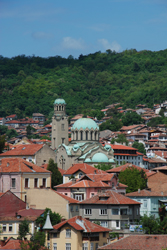
The fortress is a couple gates and a series of walls enclosing a large area. Inside are a mishmash of ruins: Roman and Byzantine columns, restored tower walls, a church foundation.
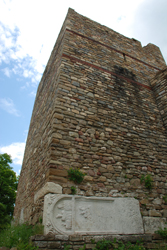
At one end we saw a tree with pretty red and white yarn bracelets tied to it. We overheard a Bulgarian man explaining to a group that it was a tradition of welcoming spring. When the first swallows return from Africa, you must tie a bracelet on the first tree which has flowers for good luck.
The church which crowns the fortress and town is a small chapel in the typical Bulgarian style with metal domes and bricks. The inside was entirely painted with very modern looking expressionist religious scenes.
While Deena and I had been off chasing train tickets, Rowshan had a chance to visit another structure in the town with a statue of horsemen near it.
Down by the river he met some kids and was shocked to realize they spoke Turkish. It turned out they were Turkish Romany who lived in Bulgaria.
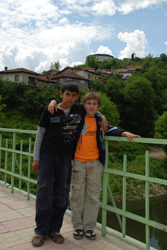
We spent the rest of our time eating dinner (at the restaurant that served food in a timely manner) and watching more music and dance performances.
[ View 1 Comments
|
]
Transylvania without Vampires
10 May, 2008, 10:27 am in "Romania"
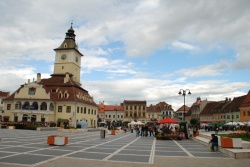 Green-- lots of green-- fields, trees, mountains, along the side of the train. There are also flashes of red poppies dotting the green. Other more subtle flowers, yellow and purple, also add splashes of color.
Green-- lots of green-- fields, trees, mountains, along the side of the train. There are also flashes of red poppies dotting the green. Other more subtle flowers, yellow and purple, also add splashes of color. 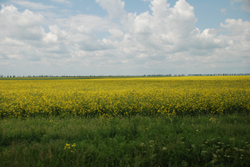
Occasionally we get glimpses of local people walking along the road near the tracks or working in the fields.
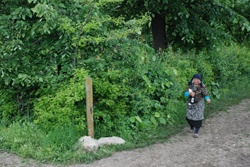
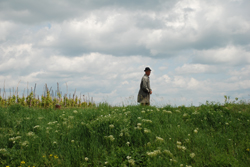
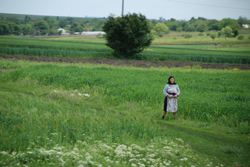
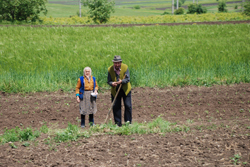
We arrived in Brasov late in the evening, something Rowshan and I generally try to avoid. I was hoping to be greeted by a room tout but unfortunately, there wasn't a single one. Instead we took a bus to the center and got a room in a Lonely Planet listed hotel whose prices have gone up from 16 Euros to about 24. We weren't going to bother trying other places since it was late.
Transylvania in spring is anything but spooky and ominous. It's kind of funny that Dracula has given the place a permanent reputation for being the land of Gothic horror. Right now everything is green except in the tops of the large mountains which are streaked with the last snows.
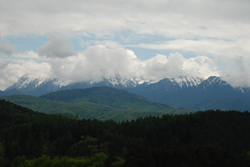
The other mountains, non-threatening and rounded, look more like hills and suggest gnomes rather than vampires. This fact is further emphasized by the profuse amount of garden gnomes occupying the yards and gardens of many houses. In the city, the buildings are bright, clean and well restored and the parks are decorated with red, yellow and purple tulips.
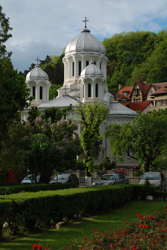
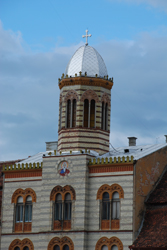
Brasov has grown since the last time I was there, which of course is expected. The area of the old town which has been restored has also grown.
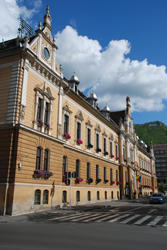
The town is at the foot of some hills.
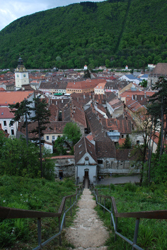
It is a pretty city with the pastel painted restored old town, some of the remaining stone walls, parks and open plazas.
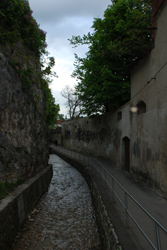
This morning we set off for Bran castle. Bran, the town, has gotten larger as well. Sprawling out from the castle are tourist complexes and lots of new houses.
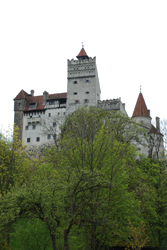
The castle is nice though all the souvenir stalls at the base are a bit overwhelming. The castle was packed. Though the souvenirs sold at its base tout the "Dracula's Castle" bit, there is no mention of Dracula in the castle. In fact, the only connection is that Vlad Tepes ("Dracula") may have been imprisoned there for a couple days by the Ottomans. Inside are mostly pieces that had belonged to Queen Marie and Princess Ileana.
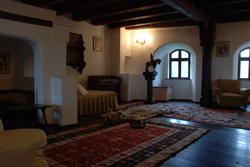
There were many photos of the queen (and princess) on the walls and I immediately adored her. She was a queen straight out of an Art Nouveau fairy tale. Photos showed her standing in a long robe, hair gently curled around her face, a long necklace and an otherworldly expression on her face. I don't know her background but she looked more like a fairy queen than Queen of Romania. (a bit of quick Google research showed that she was born the Princess of Edinburgh).
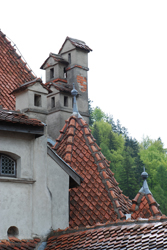
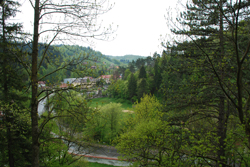
We took a walk around the castle grounds which revealed an interesting house at the base as well, as a secret door. Apparently there is a secret passage leading from the well in the courtyard of the castle to the base of the castle (though I'm not sure if this is actually the exit door).
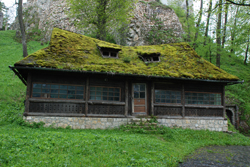
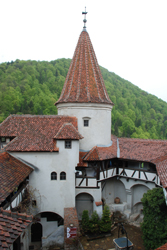
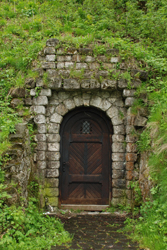
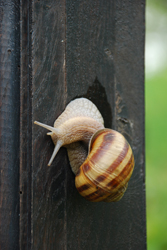
After that, Deena and I walked up a road where we saw a man with a horse drawn carriage selling hand-made brooms and carved wooden rakes and pitchforks. We saw some cute sheep who peered out of the windows of their barn.
I've been dreaming of the little bakeries which used to be everywhere, where I could buy ridiculously cheap but delicious cakes and sit at an outside table, drinking coffee and eating pastries. There are lots of tables on the square but they are all for restaurants and bars and I so far haven't seen a single bakery with that tempting selection of cakes and tortes. A tragic loss indeed.
My sweet tooth was saved, however, by a little window selling gogosi, deep fried dough filled with various fillings, one of which was melted dark chocolate. They were sprinkled with sugar and were delicious. We did eventually find a bakery that had yummy looking cakes but they were bigger and more expensive: not the type of thing you could order 3 of.
Meanwhile, Rowshan hiked up to the fortress/town of Rasnov.
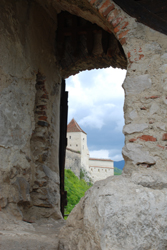
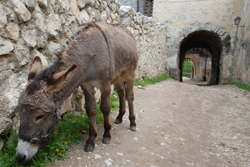
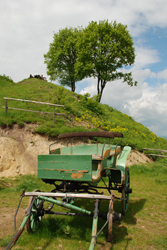
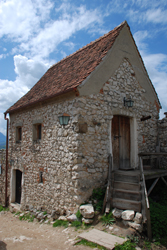
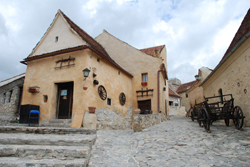
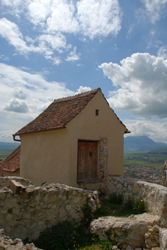
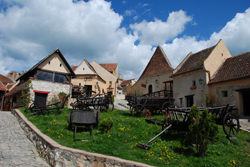
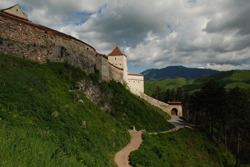
There were no tourists, the view was stunning and he thoroughly enjoyed himself.
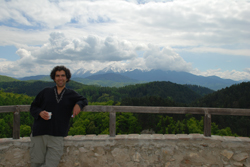
One of the interesting sites was a well that had been dug 146 meters from the top of the hill to the water level by 2 Turkish prisoners, who had been promised freedom upon finishing. It took them 17 years to dig the well.
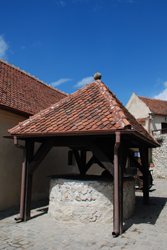
Back in town, he took in the sights of Brasov at night. Even then, I don't think they look very spooky.
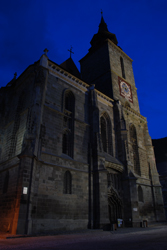
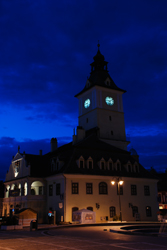
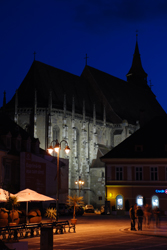
Rowshan took a photo of a woman with a bouquet of flowers. When he later returned and gave her a print of it, she was delighted by it and gave Rowshan a big hug.
